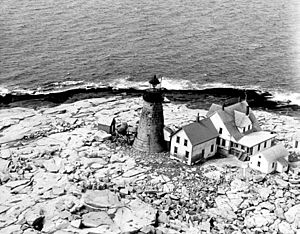Mount Desert Light facts for kids
 |
|
| The 1847 (current) tower with the 1892 keeper's house. |
|
|
|
|
| Location | South of Mount Desert Island, Maine |
|---|---|
| Coordinates | 43°58′7.01″N 68°7′42.012″W / 43.9686139°N 68.12833667°W |
| Year first constructed | 1830 |
| Year first lit | 1847 (current tower) |
| Automated | 1977 |
| Foundation | Surface rock |
| Construction | Granite blocks |
| Tower shape | Conical Tower |
| Markings / pattern | Natural granite, black lantern |
| Focal height | 75 ft (23 m) |
| Original lens | 3rd order Fresnel Lens |
| Current lens | VRB-25 |
| Range | 20 nmi (37 km; 23 mi) |
| Characteristic | Fl W 15s |
| Fog signal | HORN: 2 every 30s operates continuously |
| Admiralty number | J0048 |
| ARLHS number | USA-516 |
| USCG number | 1–5 (the first lighthouse in the Light List) |
Mount Desert Light is a famous lighthouse located on Mount Desert Rock. This small island is about 18 nautical miles (33 km; 21 mi) (29 km) south of Mount Desert Island in Maine, USA. Lighthouses are like tall towers with bright lights. They help ships find their way safely at sea, especially at night or in bad weather. The first light station here was built in 1830. The lighthouse you see today was built in 1847. It's an important historical site. It was added to the National Register of Historic Places in 1988.
Contents
The Story of Mount Desert Light
Building a Beacon
The lighthouse tower is made of strong granite blocks. It was designed by a famous architect named Alexander Parris. He designed many lighthouses in Maine. In 1858, a bell tower was added. It had a fog bell to warn ships when it was foggy. A new lantern was also installed with a special 3rd order Fresnel lens. This type of lens helps make the light much brighter and stronger.
Changes Over Time
In 1889, the fog bell was replaced by a steam-powered whistle. This whistle made a loud sound to guide ships. The house where the lighthouse keepers lived was built in 1892. In 1931, the lighthouse got electricity. This made it easier to power the light.
The lighthouse became automated in 1977. This means machines took over the work of the keepers. Around that time, the old lantern was removed. The Fresnel lens was replaced with a modern aero-beacon. In 1985, a copy of the original lantern was put back. Around 1995, the aero-beacon was updated to a VRB-25 lighthouse system. This is a very efficient lighting system.
A Research Station
In 1998, the lighthouse station was given to the College of the Atlantic. This was part of a special program called the Maine Lights program. Today, the station is used as a research center for studying nature. Scientists there mostly study large sea animals like finback and humpback whales. They learn about these amazing creatures and how to protect them.
Surviving the Storms
Mount Desert Light is located farther out in the ocean than any other lighthouse on the east coast. This means it is very exposed to bad weather. It has been damaged by strong storms. For example, it was hit hard by Hurricane Daisy (1962) and Hurricane Bill (2009).
In August 2009, Hurricane Bill caused a lot of damage. The boathouse was washed away by the waves. Two walls of the building where the generator was kept were torn apart. The first floor of the keeper's house was flooded almost to the ceiling. All the furniture and equipment inside were ruined. Because of this damage, the college's research station had to close. It reopened in August 2010 after repairs.


